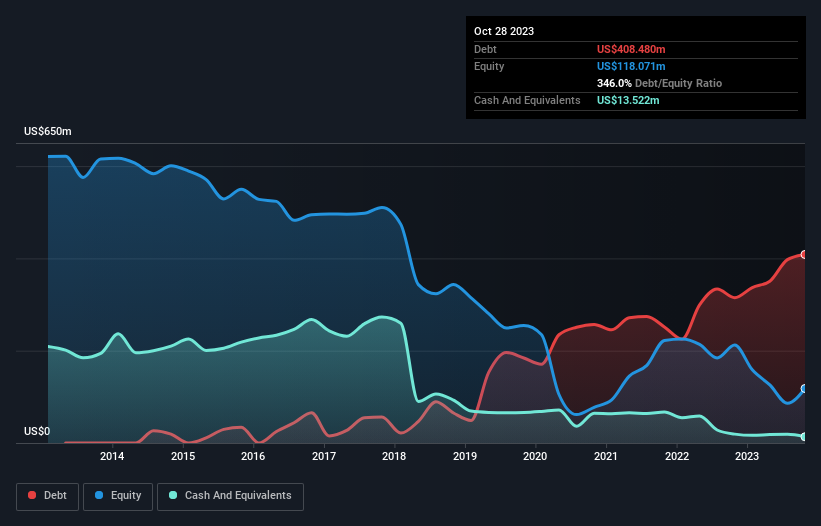- United States
- /
- Specialty Stores
- /
- NasdaqGS:PLCE
Health Check: How Prudently Does Children's Place (NASDAQ:PLCE) Use Debt?

Some say volatility, rather than debt, is the best way to think about risk as an investor, but Warren Buffett famously said that 'Volatility is far from synonymous with risk.' So it might be obvious that you need to consider debt, when you think about how risky any given stock is, because too much debt can sink a company. We note that The Children's Place, Inc. (NASDAQ:PLCE) does have debt on its balance sheet. But is this debt a concern to shareholders?
What Risk Does Debt Bring?
Debt is a tool to help businesses grow, but if a business is incapable of paying off its lenders, then it exists at their mercy. In the worst case scenario, a company can go bankrupt if it cannot pay its creditors. While that is not too common, we often do see indebted companies permanently diluting shareholders because lenders force them to raise capital at a distressed price. Of course, plenty of companies use debt to fund growth, without any negative consequences. The first thing to do when considering how much debt a business uses is to look at its cash and debt together.
Check out our latest analysis for Children's Place
What Is Children's Place's Net Debt?
The image below, which you can click on for greater detail, shows that at October 2023 Children's Place had debt of US$408.5m, up from US$314.7m in one year. However, it does have US$13.5m in cash offsetting this, leading to net debt of about US$395.0m.

How Strong Is Children's Place's Balance Sheet?
According to the last reported balance sheet, Children's Place had liabilities of US$705.7m due within 12 months, and liabilities of US$149.6m due beyond 12 months. On the other hand, it had cash of US$13.5m and US$70.8m worth of receivables due within a year. So it has liabilities totalling US$771.0m more than its cash and near-term receivables, combined.
The deficiency here weighs heavily on the US$260.5m company itself, as if a child were struggling under the weight of an enormous back-pack full of books, his sports gear, and a trumpet. So we'd watch its balance sheet closely, without a doubt. At the end of the day, Children's Place would probably need a major re-capitalization if its creditors were to demand repayment. The balance sheet is clearly the area to focus on when you are analysing debt. But ultimately the future profitability of the business will decide if Children's Place can strengthen its balance sheet over time. So if you're focused on the future you can check out this free report showing analyst profit forecasts.
In the last year Children's Place had a loss before interest and tax, and actually shrunk its revenue by 8.9%, to US$1.6b. That's not what we would hope to see.
Caveat Emptor
Importantly, Children's Place had an earnings before interest and tax (EBIT) loss over the last year. Its EBIT loss was a whopping US$67m. Combining this information with the significant liabilities we already touched on makes us very hesitant about this stock, to say the least. That said, it is possible that the company will turn its fortunes around. But we think that is unlikely, given it is low on liquid assets, and burned through US$73m in the last year. So we consider this a high risk stock and we wouldn't be at all surprised if the company asks shareholders for money before long. When analysing debt levels, the balance sheet is the obvious place to start. But ultimately, every company can contain risks that exist outside of the balance sheet. We've identified 4 warning signs with Children's Place (at least 2 which are a bit unpleasant) , and understanding them should be part of your investment process.
If you're interested in investing in businesses that can grow profits without the burden of debt, then check out this free list of growing businesses that have net cash on the balance sheet.
New: AI Stock Screener & Alerts
Our new AI Stock Screener scans the market every day to uncover opportunities.
• Dividend Powerhouses (3%+ Yield)
• Undervalued Small Caps with Insider Buying
• High growth Tech and AI Companies
Or build your own from over 50 metrics.
Have feedback on this article? Concerned about the content? Get in touch with us directly. Alternatively, email editorial-team (at) simplywallst.com.
This article by Simply Wall St is general in nature. We provide commentary based on historical data and analyst forecasts only using an unbiased methodology and our articles are not intended to be financial advice. It does not constitute a recommendation to buy or sell any stock, and does not take account of your objectives, or your financial situation. We aim to bring you long-term focused analysis driven by fundamental data. Note that our analysis may not factor in the latest price-sensitive company announcements or qualitative material. Simply Wall St has no position in any stocks mentioned.
About NasdaqGS:PLCE
Children's Place
Operates an omni-channel children’s specialty portfolio of brands in North America.
Moderate and fair value.


